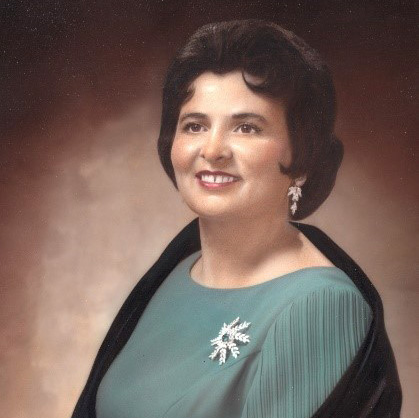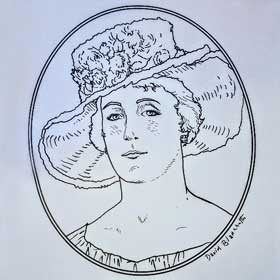Abolitionist and social reformer Rosetta Douglass (1839-1906) continued a family legacy of activism that began in New Bedford with her parents, Frederick and Anna Murray Douglass. Rosetta delivered her most notable speech, a paper entitled “Anna Murray Douglass – My Mother as I Recall Her,” as an acknowledgement of the essential part that Anna played in Frederick’s rise to becoming a renowned author and orator.
As an abolitionist and social reformer, Rosetta Douglass (1839-1906) continued a family legacy of activism that began in New Bedford. Soon after his arrival in New Bedford, her father Frederick Douglass became active in New Bedford’s abolitionist movement and gained increasing prominence throughout Massachusetts and beyond. Frederick and Anna Murray Douglass arrived in New Bedford in 1838 and first lived with Nathan and Polly Johnson in their home at 21 Seventh Street. By 1839, they moved to 157 Elm Street, where Rosetta, their first child, was born that year. In 1842, the Douglasses moved to Lynn and then by 1848 to Rochester, New York.
Frederick and Anna were committed to the intellectual development of their five children. At about the age of six, Rosetta was sent to Albany, New York, to be tutored by Quaker abolitionist sisters Abigail and Lydia Mott, cousins of abolitionist and feminist Lucretia Mott. Upon Rosetta’s return home to her parents in Rochester, she and her siblings were tutored by Phebe Thayer, a Quaker governess. In 1848, Rosetta passed the entrance exam and was accepted into the Seward Seminary, a prestigious school for girls in Rochester. Rosetta, at the time the only African American student at Seward, was segregated from the White students and taught in a separate room. Her angry father chronicled Rosetta’s experience of racism in his newspaper, North Star. Frederick then took up the cause of desegregation of Rochester public schools. Its separate schools were soon abolished.
Rosetta eventually attended Oberlin College’s Preparatory Department and New Jersey’s Salem Normal School. She worked as her father’s assistant, then taught school in Salem, New Jersey. Through Rosetta, Frederick became increasingly aware of the struggles that African American parents experienced as they tried to educate their children. Rosetta learned about activism first hand in her father’s office, where she began folding papers at age 11. Later on, she took dictation from him for his editorials and lectures. As she learned the administrative tasks behind abolitionist and women’s rights causes, Rosetta developed a strong sense of racial justice and gender equality.
Close to her father, she advised him against accepting the presidency of the Freedmen’s Bank, a bank that had been set up to assist freedmen in their transition from slavery to freedom. By 1874, the bank was plagued by bad investments and corruption, and Frederick was elected president in hopes of saving it. Despite Rosetta’s concern, Frederick accepted the presidency. The bank closed months later.
Rosetta gradually increased her own public appearances in support of abolitionism, African American education and women’s rights. After her father’s death in 1895, Rosetta took on a more active role in various organizations. In 1896, she attended the first conference of the National Federation of Afro-American Women in Washington, D.C. There, along with Harriet Tubman and other attendees, Rosetta became a founding member of the National Association of Colored Women’s Clubs, part of the clubwomen’s movement, a network of self-help groups launched by African American women.
On May 10, 1900, at the Women’s Christian Temperance Union, Rosetta delivered her most notable speech, a paper entitled “Anna Murray Douglass – My Mother as I Recall Her,” a tribute to her mother’s role in the life of Frederick Douglass. Rosetta’s paper, an acknowledgement of the essential part that Anna played in Frederick’s rise to becoming a renowned author and orator, provides an important glimpse into Anna’s background and her relationship with Frederick. Anna Murray, born in freedom in Maryland, became a housekeeper in Baltimore, saved most of her earnings, and shared everything so that Frederick could escape slavery. From the early days of their marriage in New Bedford, Anna and Frederick accepted separate domains with Anna in charge of the household while Frederick worked outside the home and eventually in the public sphere of social activism. During Frederick’s absences, Anna worked by binding shoes to supplement his earnings. Rosetta adds that Anna was a “recognized co-worker” in the Anti-Slavery Societies of Lynn and Boston and that she attended meetings regularly. Rosetta points out that her father often acknowledged Anna’s “executive ability,” evidenced in the fact that no debts were incurred during his absences due to Anna’s money management. As a vital agent along the Underground Railroad, Anna accommodated freedom seekers in the Douglass home with comfortable rooms and suppers “at all hours of the night.” Rosetta explains that even though her mother could read only a little, she was interested in remaining informed about every aspect of the anti-slavery movement. In short, for Rosetta, the career of Frederick Douglass was made possible by the loyalty and courage of her mother.
Rosetta married Nathan Sprague, a former slave and Union soldier, on December 24, 1863. With little education and few skills, Nathan was unable to keep a job and ended up in prison for mail theft. With six children to raise, Rosetta was the main source of income throughout the stormy marriage. In her later years, Rosetta dedicated herself to her children and social justice organizations.
Ann O’Leary, Emily Bourne Research Fellow
Information from
-
Becker, Thea Gallo. “Sprague, Rosetta M. Douglass.” African American Women: A Biographical Dictionary. Garland Publishing, 1993.
-
Gregory, James M. Frederick Douglass the Orator. Willey, 1893.
-
Sprague, Rosetta Douglass. Anna Murray Douglass, My Mother As I Recall Her. 1900. Library of Congress, https://www.loc.gov/item/mfd.02007/.
-
Temple, Christel. “Douglass Sprague, Rosetta (1839-1906).” The Frederick Douglass Encyclopedia. Greenwood Publishing, 2010, pp. 49-50.
![[Rosetta Douglass], c. 1880, Photograph, Courtesy of National Park Service Photo of abolitionist Rosetta Douglass](https://historicwomensouthcoast.org/wp-content/uploads/2018/02/Rosetta-Douglass-500x500.jpg)




